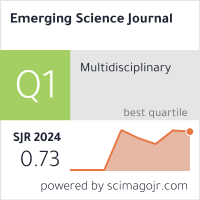Artificial Intelligence and Competitive Advantage of Tourism Enterprises: A Chain Mediation Effect
Downloads
In the era of artificial intelligence (AI), tourism companies are leveraging AI to enhance their competitive advantage. Drawing on competition theory, this paper explores the relationships among AI application, innovation capability, organizational culture, and competitive advantage, and verifies the chain mediating effect of innovation capability and organizational culture. Data from 400 tourism enterprises in China were collected through a survey questionnaire, and multiple regression analysis was employed. The results indicate that AI application has a positive and significant effect on the competitive advantage of enterprises. Innovation capability mediates the relationship between AI application and competitive advantage, as does organizational culture. Furthermore, innovation capability and organizational culture exhibit a chain mediating effect. This study broadens the understanding of AI applications in the tourism industry and elucidates the mechanism through which AI influences the competitive advantage of enterprises.
Downloads
[1] Ghosh, B., Daugherty, P. R., Wilson, H. J., & Burden, A. (2019). Taking a systems approach to adopting AI. Harvard Business Review, 9.
[2] Kemp, A. (2024). Competitive advantage through artificial intelligence: Toward a theory of situated AI. Academy of Management Review, 49(3), 618–635. doi:10.5465/amr.2020.0205.
[3] Hendrayati, H., Achyarsyah, M., Marimon, F., Hartono, U., & Putit, L. (2024). The Impact of Artificial Intelligence on Digital Marketing: Leveraging Potential in a Competitive Business Landscape. Emerging Science Journal, 8(6), 2343–2359. doi:10.28991/esj-2024-08-06-012.
[4] Álvarez Jaramillo, J., Zartha Sossa, J. W., & Orozco Mendoza, G. L. (2018). Barriers to sustainability for small and medium enterprises in the framework of sustainable development—Literature review. Business Strategy and the Environment, 28(4), 512-524. doi:10.1002/bse.2261.
[5] Rai, A., Constantinides, P., & Sarker, S. (2019). Editor’s comments: Next-generation digital platforms: Toward human–AI hybrids. MIS Quarterly, 43(1), 1–9.
[6] Yablonsky, S. A. (2019). Multidimensional data-driven artificial intelligence innovation. Technology Innovation Management Review, 9(12), 16–28. doi:10.22215/timreview/1288.
[7] Samara, D., Magnisalis, I., & Peristeras, V. (2020). Artificial intelligence and big data in tourism: A systematic literature review. Journal of Hospitality and Tourism Technology, 11(2), 343–367. doi:10.1108/jhtt-12-2018-0118.
[8] Rahman, M., Ming, T. H., Baigh, T. A., & Sarker, M. (2021). Adoption of artificial intelligence in banking services: An empirical analysis. International Journal of Emerging Markets, 724. doi:10.1108/ijoem-06-2020-0724.
[9] Wijijayanti, T., Agustina, Y., Winarno, A., Istanti, L., & Dharma, B. (2020). Rural tourism: A local economic development. Australasian Accounting, Business and Finance Journal, 14(1), 5–13. doi:10.14453/aabfj.v14i1.2.
[10] Moore, A. (2019). When AI becomes an everyday technology. Harvard Business Review, 7.
[11] Huang, M.-H., & Rust, R. T. (2018). Artificial intelligence in service. Journal of Service Research, 21(2), 155–172. doi:10.1177/1094670517752459.
[12] Pillai, R., & Sivathanu, B. (2020). Adoption of artificial intelligence (AI) for talent acquisition in IT/ITeS organizations. Benchmarking: An International Journal, 27(9), 2599–2629.
[13] Swamy, C. J., Beloor, V., & Nanjundeswaraswamy, T. S. (2021). Recruitment and selection process in the IT firms. GIS Science Journal, 8, 343–356.
[14] Upadhyay, A. K., & Khandelwal, K. (2018). Applying artificial intelligence: Implications for recruitment. Strategic HR Review, 17(5), 255–258.
[15] da Silva, L. B. P., Soltovski, R., Pontes, J., Treinta, F. T., Leitão, P., Mosconi, E., de Resende, L. M. M., & Yoshino, R. T. (2022). Human resources management 4.0: Literature review and trends. Computers & Industrial Engineering, 168, 108111. doi:10.1016/j.cie.2022.108111.
[16] Lu, X. (2022). A human resource demand forecasting method based on improved BP algorithm. Computational Intelligence and Neuroscience, 2022, Article 3534840. doi:10.1155/2022/3534840.
[17] Votto, A. M., Valecha, R., Najafirad, P., & Rao, H. R. (2021). Artificial intelligence in tactical human resource management: A systematic literature review. International Journal of Information Management Data Insights, 1(2), 100047. doi:10.1016/j.jjimei.2021.100047.
[18] Krakowski, S., Luger, J., & Raisch, S. (2022). Artificial intelligence and the changing sources of competitive advantage. Strategic Management Journal, 44(6), 1425–1452. doi:10.1002/smj.3387.
[19] Fountaine, T., McCarthy, B., & Saleh, T. (2019). Building the AI-powered organization. Harvard Business Review, 97(4), 62–73.
[20] Makarius, E. E., Mukherjee, D., Fox, J. D., & Fox, A. K. (2020). Rising with the machines: A sociotechnical framework for bringing artificial intelligence into the organization. Journal of Business Research, 120, 262–273. doi:10.1016/j.jbusres.2020.07.045.
[21] Ivanov, S., & Webster, C. (2019). Economic fundamentals of the use of robots, artificial intelligence, and service automation in travel, tourism, and hospitality. In Robots, artificial intelligence, and service automation in travel, tourism and hospitality, 39–55. doi:10.1108/978-1-78756-687-320191002.
[22] Doborjeh, Z., Hemmington, N., Doborjeh, M., & Kasabov, N. (2022). Artificial intelligence: A systematic review of methods and applications in hospitality and tourism. International Journal of Contemporary Hospitality Management, 34(3), 1154–1176. doi:10.1108/IJCHM-06-2021-0767.
[23] Moreno-Izquierdo, L., Egorova, G., Peretó Rovira, A., & Más-Ferrando, A. (2018). Exploring the use of artificial intelligence in price maximization in the tourism sector: Its application in the case of Airbnb in the Valencian Community. Investigaciones Regionales – Journal of Regional Research, 42, 113–128.
[24] Citak, J., Owoc, M. L., & Weichbroth, P. (2021). A note on the applications of artificial intelligence in the hospitality industry: Preliminary results of a survey. Procedia Computer Science, 192, 4552–4559. doi:10.1016/j.procs.2021.09.233.
[25] Lukanova, G., & Ilieva, G. (2019). Robots, artificial intelligence, and service automation in hotels. In S. Ivanov & C. Webster (Eds.), Robots, artificial intelligence, and service automation in travel, tourism and hospitality, 157–183.
[26] Bulchand‑Gidumal, J. (2022). Impact of artificial intelligence in travel, tourism, and hospitality. Handbook of e-Tourism, 1943–1962.
[27] Mariani, M., & Baggio, R. (2022). Big data and analytics in hospitality and tourism: A systematic literature review. International Journal of Contemporary Hospitality Management, 34(1), 231–278. doi:10.1108/IJCHM-03-2021-0301.
[28] Ku, E. C. S., & Chen, C.-D. (2024). Artificial intelligence innovation of tourism businesses: From satisfied tourists to continued service usage intention. International Journal of Information Management, 76, 102757. doi:10.1016/j.ijinfomgt.2024.102757.
[29] Jaiswal, A., Arun, C. J., & Varma, A. (2022). Rebooting employees: Upskilling for artificial intelligence in multinational corporations. The International Journal of Human Resource Management, 33(6), 1179–1208.
[30] Hussein, H., Albadry, O. M., Mathew, V., Al‑Romeedy, B. S., Alsetoohy, O., Abou Kamar, M., & Khairy, H. A. (2024). Digital leadership and sustainable competitive advantage: Leveraging green absorptive capability and eco‑innovation in tourism and hospitality businesses. Sustainability, 16, Article 5371. doi:10.3390/su16135371.
[31] Kaplan, A., & Haenlein, M. (2020). Rulers of the world, unite! The challenges and opportunities of artificial intelligence. Business Horizons, 63(1), 37–50. doi:10.1016/j.bushor.2019.09.003.
[32] Dhaheri, M. H., Ahmad, S. Z., & Papastathopoulos, A. (2024). Do environmental turbulence, dynamic capabilities, and artificial intelligence force SMEs to be innovative? Journal of Innovation & Knowledge, 9(3), 100528. doi:10.1016/j.jik.2024.100528.
[33] Keding, C., & Meissner, P. (2021). Managerial overreliance on AI-augmented decision-making processes: How the use of AI-based advisory systems shapes choice behavior in R&D investment decisions. Technological Forecasting and Social Change, 171, 120970. doi:10.1016/j.techfore.2021.120970.
[34] Murray, A., Rhymer, J., & Sirmon, D. G. (2021). Humans and technology: Forms of conjoined agency in organizations. Academy of Management Review, 46(3), 552–571. doi:10.5465/amr.2019.0186.
[35] Acar, A. Z., & Acar, P. (2012). The effects of organizational culture and innovativeness on business performance in healthcare industry. Procedia – Social and Behavioral Sciences, 58, 683–692. doi:10.1016/j.sbspro.2012.09.1046.
[36] Moser, C., Glaser, V. L., & Lindebaum, D. (2024). Taking situatedness seriously in theorizing about competitive advantage through artificial intelligence: A response to Kemp’s “Competitive advantages through artificial intelligence”. Academy of Management Review, 49(3), 6–685. doi:10.5465/amr.2023.0265.
[37] Siddik, A. B., Forid, M. S., Yong, L., Du, A. M., & Goodell, J. W. (2024). Artificial intelligence as a catalyst for sustainable tourism growth and economic cycles. Technological Forecasting and Social Change, 210, 123875. doi:10.1016/j.techfore.2024.123875.
[38] Koo, C., Xiang, Z., Gretzel, U., & Sigala, M. (2021). Artificial intelligence (AI) and robotics in travel, hospitality and leisure. Electronic Markets, 31(3), 473–476. doi:10.1007/s12525-021-00494-z.
[39] Xu, S., Kee, K. F., Li, W., Yamamoto, M., & Riggs, R. E. (2023). Examining the Diffusion of Innovations from a Dynamic, Differential-Effects Perspective: A Longitudinal Study on AI Adoption Among Employees. Communication Research, 51(7), 843–866. doi:10.1177/00936502231191832.
[40] Łapińska, J., Escher, I., Górka, J., Sudolska, A., & Brzustewicz, P. (2021). Employees’ trust in artificial intelligence in companies: The case of energy and chemical industries in Poland. Energies, 14(7), 1942. doi:10.3390/en14071942.
[41] Prem, E. (2019). Artificial intelligence for innovation in Austria. Technology Innovation Management Review, 9(12), 5–15. doi:10.22215/timreview/1287.
[42] Haenlein, M., & Kaplan, A. (2019). A brief history of artificial intelligence: On the past, present, and future of artificial intelligence. California Management Review, 61(4), 5–14. doi:10.1177/0008125619864925.
[43] Benbya, H., Pachidi, S., & Jarvenpaa, S. L. (2021). Special issue editorial: Artificial intelligence in organizations: Implications for information systems research. Journal of the Association for Information Systems, 22(2), 281–303. doi:10.17705/1jais.00662.
[44] Ågerfalk, P. J. (2020). Artificial intelligence as digital agency. European Journal of Information Systems, 29(1), 1–8. doi:10.1080/0960085X.2020.1721947.
[45] Ivanov, S., & Webster, C. (2019). Conceptual framework of the use of robots, artificial intelligence and service automation in travel, tourism, and hospitality companies. Robots, artificial intelligence, and service automation in travel, tourism and hospitality, 7–37.
[46] Issa, H., Jabbouri, R., & Palmer, M. (2022). An artificial intelligence (AI)-readiness and adoption framework for AgriTech firms. Technological Forecasting and Social Change, 182, 121874. doi:10.1016/j.techfore.2022.121874.
[47] Dash, R., McMurtrey, M., Rebman, C., & Kar, U. K. (2019). Application of artificial intelligence in automation of supply chain management. Journal of Strategic Innovation and Sustainability, 14(3), 43–53.
[48] Li, B., Mi, Z., & Zhang, Z. (2020). Willingness of the new generation of farmers to participate in rural tourism: The role of perceived impacts and sense of place. Sustainability, 12(3), 766. doi:10.3390/su12030766.
[49] Popesku, J. (2019). Current applications of artificial intelligence in tourism and hospitality. Sinteza 2019 – International Scientific Conference on Information Technology and Data Related Research, 84-90.
[50] Ansoff, H. I. (1965). The concept of strategy. McGraw‑Hill, New York, United States.
[51] Barney, J. (1991). Firm resources and sustained competitive advantage. Journal of Management, 17(1), 99–120. doi:10.1177/014920639101700108.
[52] Kapoor, R., & Adner, R. (2012). What firms make vs. what they know: How firms’ production and knowledge boundaries affect competitive advantage in the face of technological change. Organization Science, 23(5), 1227–1248. doi:10.1287/orsc.1110.0686.
[53] Davenport, T., Guha, A., Grewal, D., & Bressgott, T. (2020). How artificial intelligence will change the future of marketing. Journal of the Academy of Marketing Science, 48(1), 24–42. doi:10.1007/s11747-019-00696-0.
[54] Porter, M. E. (1990). The competitive advantage of nations. Free Press, New York, United States.
[55] Dierickx, I., & Cool, K. (1989). Asset stock accumulation and sustainability of competitive advantage. Management Science, 35(12), 1504–1511. doi:10.1287/mnsc.35.12.1504.
[56] Grant, R. M. (1991). The resource-based theory of competitive advantage: Implications for strategy formulation. California Management Review, 33(3), 114–135. doi:10.2307/41166664.
[57] Adebanjo, D., Abbas, A., & Mann, R. (2018). An investigation of the adoption and implementation of benchmarking. Benchmarking: An International Journal, 25(9), 3622–3645. doi:10.1108/BIJ-09-2017-0250.
[58] Kaiming, G. (2019). Artificial Intelligence Structural Transformation and Labor Share. Journal of Management World, 7, 60-77.
[59] Wei, Z. W. L. X. Y. S. B. W. (2021). Industrial intelligence, labor structure and industrial structure upgrading. Studies in Science of Science, 39(8), 1384–1395. doi:10.16192/j.cnki.1003-2053.20201119.002.
[60] Alekseeva, L., Giné, M., Samila, S., & Taska, B. (2020). AI adoption and firm performance: Management versus IT. SPGMI: CompStat Fundamentals, 1-40. doi:10.2139/ssrn.3677237.
[61] Baabdullah, A. M., Alalwan, A. A., Slade, E. L., Raman, R., & Khatatneh, K. F. (2021). SMEs and artificial intelligence (AI): Antecedents and consequences of AI‑based B2B practices. Industrial Marketing Management, 98, 255–270. doi:10.1016/j.indmarman.2021.09.003.
[62] Pillai, R., & Sivathanu, B. (2020). Adoption of AI‑based chatbots for hospitality and tourism. International Journal of Contemporary Hospitality Management, 32(10), 3199–3226. doi:10.1108/IJCHM-04-2020-0259.
[63] Chen, Q., Wang, C. H., & Huang, S. Z. (2020). Effects of organizational innovation and technological innovation capabilities on firm performance: Evidence from firms in China’s Pearl River Delta. Asia Pacific Business Review, 26(1), 72–96.
[64] Yam, R. C. M., Lo, W., Tang, E. P. Y., & Lau, A. K. W. (2011). Analysis of sources of innovation, technological innovation capabilities, and performance: An empirical study of Hong Kong manufacturing industries. Research Policy, 40, 391–402. doi:10.1016/j.respol.2010.11.006.
[65] Eisenhardt, K. M., & Santos, F. M. (2002). Knowledge-based view: A new theory of strategy? Handbook of Strategy and Management. Sage, London, United Kingdom.
[66] Xu, Q. R., Wu, Z. Y., & Chen, L. T. (2013). An analysis of the evolution path to and the driving factors of the independent innovation of enterprises in the transitional economy: A longitudinal case study on Haier Group from 1984 to 2013. Management World, (4), 121–134.
[67] Sok, P., & O’Cass, A. (2011). Achieving superior innovation-based performance outcomes in SMEs through innovation resource–capability complementarity. Industrial Marketing Management, 40(8), 1285–1293. doi:10.1016/j.indmarman.2011.10.007.
[68] Bigliardi, B., Colacino, P., & Dormio, A. I. (2011). Innovative characteristics of small and medium enterprises. Journal of Technology Management & Innovation, 6(2), 83–93. doi:10.4067/S0718-27242011000200006.
[69] Kinkel, S., Baumgartner, M., & Cherubini, E. (2021). Prerequisites for the adoption of AI technologies in manufacturing – Evidence from a worldwide sample of manufacturing companies. Technovation, 110, 102375. doi:10.1016/j.technovation.2021.102375.
[70] Gursoy, F., & Kakadiaris, I. (2023). Artificial intelligence research strategy of the United States: Critical assessment and policy recommendations. Frontiers in Big Data, 6, 1206139. doi:10.3389/fdata.2023.1206139.
[71] Peters, T. J., & Waterman, R. H., Jr. (1982). In Search of Excellence: Lessons from America’s best‑run companies. Harper & Row, New York, United States.
[72] Deal, T. E., & Kennedy, A. A. (1982). Corporate Cultures: The Rites and Rituals of Corporate Life. Perseus Publishing, New York, United States.
[73] Azeem, M., Ahmed, M., Haider, S., & Sajjad, M. (2021). Expanding competitive advantage through organizational culture, knowledge sharing and organizational innovation. Technology in Society, 66, 101635. doi:10.1016/J.TECHSOC.2021.101635.
[74] Turktarhan, G., Aleong, D. S., & Aleong, C. (2022). Re-architecting the firm for increased value: How business models are adapting to the new AI environment. Journal of Global Business Insights, 7(1), 33–49. doi:10.5038/2640-6489.7.1.1154.
[75] Wang, C.-H. (2019). How organizational green culture influences green performance and competitive advantage: The mediating role of green innovation. Journal of Manufacturing Technology Management, 30(4), 666–683. doi:10.1108/JMTM-09-2018-0314.
[76] Martínez‑García, A. N. (2022). Artificial Intelligence for Sustainable Complex Socio‑Technical‑Economic Ecosystems. Computation, 10(6). doi:10.3390/computation10060095.
[77] Jumhur, A. A., Mahmood, N., & Muchdie. (2017). Manufacturing strategy and competitive advantage: A mediating role of organizational culture (A case study of small industry batik Trusmi Indonesia). American Journal of Applied Sciences, 14(7), 711–717. doi:10.3844/AJASSP.2017.711.717.
[78] Wang, C., & Ahmed, P. K. (2007). The capacity to innovate: A meta‑analysis of absorptive capacity. Journal of Business Research, 60(3), 401–410. doi:10.1016/j.jbusres.2006.10.014.
[79] Hogan, S. J., Soutar, G. N., McColl‑Kennedy, J. R., & Sweeney, J. C. (2011). Reconceptualizing professional service firm innovation capability: Scale development. Industrial Marketing Management, 40(7), 1264–1273. doi:10.1016/j.indmarman.2011.10.002.
[80] Lawson, B., & Samson, D. (2001). Developing innovation capability in organisations: A dynamic capabilities approach. International Journal of Innovation Management, 5(3), 377–400. doi:10.1142/S1363919601000427.
[81] Brown, A. D. (1995). Organisational culture. Pitman Publishing, London, United States. doi:10.5172/jmo.1995.1.1.57.
[82] Nada, N., & Ali, Z. (2015). Service value creation capability model to assess the service innovation capability in SMEs. Procedia CIRP, 30, 390–395. doi:10.1016/j.procir.2015.02.218.
[83] Yang, Y., Liu, W., Gao, Y., & Li, Y. (2009). The impact of technological innovation capabilities on firm performance. Journal of Engineering and Technology Management, 26(4), 269–284. doi:10.1016/j.jengtecman.2009.10.006.
[84] Streimikiene, D., Svagzdiene, B., Jasinskas, E., & Simanavicius, A. (2021). Sustainable tourism development and competitiveness: The systematic literature review. Sustainable Development, 29(1), 259–271. doi:10.1002/sd.2133.
[85] Raj, R., & Srivastava, K. B. L. (2013). The mediating role of organizational learning on the relationship among organizational culture, HRM practices and innovativeness. Management and Labour Studies, 38(3), 201–223. doi:10.1177/0258042X13509738.
[86] Gürlek, M., & Tuna, M. (2018). Reinforcing competitive advantage through green organizational culture and green innovation. The Service Industries Journal, 38(3–4), 467–491. doi:10.1080/02642069.2017.1402889.
[87] Ciampi, F., Faraoni, M., Ballerini, J., & Meli, F. (2022). The co-evolutionary relationship between digitalization and organizational agility: Ongoing debates, theoretical developments and future research perspectives. Technological Forecasting and Social Change, 176, 121383. doi:10.1016/j.techfore.2021.121383.
[88] Kasser, T., & Ryan, R. M. (1996). Further examining the American Dream: Differential correlates of intrinsic and extrinsic goals. Personality and Social Psychology Bulletin, 22, 280–287. doi:10.1177/0146167296223006.
[89] Ávila, M. M. (2022). Competitive advantage and knowledge absorptive capacity: The mediating role of innovative capability. Journal of the Knowledge Economy, 13(1), 185–210. doi:10.1007/s13132-020-00672-7.
[90] Zhou, K. Z., & Wu, F. (2010). Technological capability, strategic flexibility and product innovation. Journal of Marketing, 74(4), 48–68. doi:10.1509/jmkg.74.4.48.
[91] Lee, Y. S., Kim, T., Choi, S., & Kim, W. (2022). When does AI pay off? AI‑adoption intensity, complementary investments, and R&D strategy. Technovation, 118, Article 102590. doi:10.1016/j.technovation.2022.102590.
[92] Liao, S. H., Fei, W. C., & Chen, C. C. (2007). Knowledge sharing, absorptive capacity, and innovation capability: An empirical study of Taiwan’s knowledge‑intensive industries. Journal of Information Science, 33(3), 340–359. doi:10.1177/0165551506070739.
[93] Liu, H., Ke, W., Wei, K. K., Gu, J., & Chen, H. (2010). The role of institutional pressures and organizational culture in the firm's intention to adopt internet‑enabled supply chain management systems. Journal of Operations Management, 28(5), 372–384. doi:10.1016/j.jom.2009.11.010.
[94] Dubey, R., Gunasekaran, A., Childe, S. J., Roubaud, D., Wamba, S. F., Giannakis, M., & Foropon, C. (2019). Big data analytics and organizational culture as complements to swift trust and collaborative performance in the humanitarian supply chain. International Journal of Production Economics, 210, 120–136. doi:10.1016/j.ijpe.2019.01.023.
[95] Anderson, J. C., & Gerbing, D. W. (1988). Structural equation modeling in practice: A review and recommended two‑step approach. Psychological Bulletin, 103(3), 411–423. doi:10.1037/0033‑2909.103.3.411.
[96] Hayes, A. F., & Scharkow, M. (2013). The relative trustworthiness of inferential tests of the indirect effect in statistical mediation analysis: Does method really matter? Psychological Science, 24(10), 1918–1927. doi:10.1177/0956797613480187.
[97] Cooper, R. G., & Sommer, A. F. (2018). Agile–stage‑gate for manufacturers: Changing the way new products are developed. Research‑Technology Management, 61(2), 17–26. doi:10.1080/08956308.2018.1421380.
[98] Paluch, S., Antons, D., Brettel, M., & Salge, T. O. (2019). Stage‑gate and agile development in the digital age: Promises, perils, and boundaries. Research‑Technology Management, 62(2), 20–29. doi:10.1080/08956308.2019.1563439.
[99] Sjödin, D. R., Parida, V., Leksell, M., & Petrovic, A. (2020). Transitioning from product to service‑based business models: A multi‑case study of digital servitization in industry. International Journal of Production Economics, 228, 107746. doi:10.1016/j.ijpe.2020.107746.
- This work (including HTML and PDF Files) is licensed under a Creative Commons Attribution 4.0 International License.




















